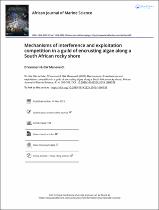| dc.contributor.author | Vanmari, Dhiren | |
| dc.contributor.author | Maneveldt, Gavin | |
| dc.date.accessioned | 2022-12-05T10:45:50Z | |
| dc.date.available | 2022-12-05T10:45:50Z | |
| dc.date.issued | 2019 | |
| dc.identifier.citation | Gavin W. Maneveldt, So Young Jeong, Tae Oh Cho, Jeffery R. Hughey, Paul W. Gabrielson. (2020) Reassessment of misapplied names, Phymatolithon ferox and P. repandum (Hapalidiales, Corallinophycidae, Rhodophyta) in South Africa, based on DNA sequencing of type and recently collected material. Phycologia 59:5, pages 449-455. | en_US |
| dc.identifier.issn | 1814-2338 | |
| dc.identifier.uri | http://hdl.handle.net/10566/8209 | |
| dc.description.abstract | Within the marine benthos, space is considered an absolute requirement that is often in limited supply. The often-low availability of this essential resource causes species to interact competitively through mechanisms of interference and exploitation. Species of encrusting algae, in particular, use overgrowth as a mechanism for interference competition, and variable growth rates have regularly been argued as a mechanism for exploitation competition. This study examined overgrowth interactions as a proxy for interference competition, and cover abundance as an indirect proxy for exploitation competition, to understand how encrusting algal species coexist. Cover abundance was shown to be tightly correlated with marginal growth rates (r = 0.99, p < 0.023), although data existed for only three of the six species examined, so it was not possible to use growth rate per se as a proxy for exploitation competition. The results additionally indicated a strong competitive hierarchy for both overgrowth competition and for cover abundance, and an inverse relationship between the two proxies (overgrowth vs cover abundance) of competition (upper mid-eulittoral zone, r = −0.81; lower mid-eulittoral zone, r = −1.00). Although postulated, none of the species that are seemingly subordinate in terms of overgrowth are excluded from their respective habitats. The reason for the coexistence between subordinate and superior overgrowth competitors can be argued through the interplay between interference and exploitation competition mechanisms, in which species that are typically always overgrown (poor interference competitors) maintain their existence largely because they are better at exploiting the limited available space because their faster growth rates result in higher cover abundances | en_US |
| dc.language.iso | en_US | en_US |
| dc.publisher | University of the Western Cape | en_US |
| dc.subject | coexistence | en_US |
| dc.subject | competitive hierarchy | en_US |
| dc.subject | competitive network | en_US |
| dc.subject | crustose algae | en_US |
| dc.subject | eulittoral zone | en_US |
| dc.title | Mechanisms of interference and exploitation competition in a guild of encrusting algae along a South African rocky shore | en_US |
| dc.type | Article | en_US |

